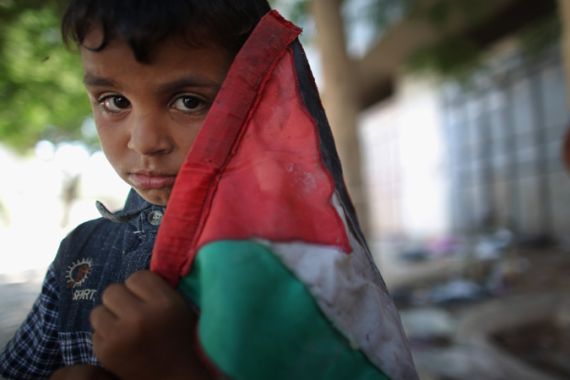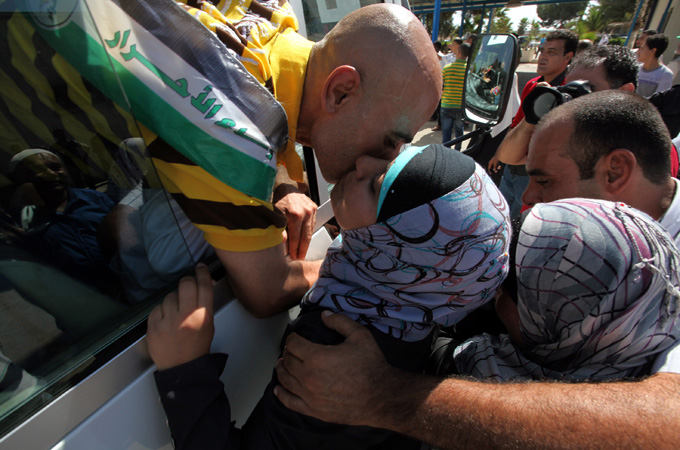Despite swap, Gaza remains imprisoned
While 1,000 Palestinian prisoners will be released, 1.8 million people living in Gaza are still not free.

 |
| Although the prisoner release is a victory for Palestinians, Gazans remain stuck in a prison of their own [EPA] |
The prisoner exchange agreement concluded between Israel and Hamas has brought relief to thousands of families eager to see their loved ones return home. In the midst of Israel’s prolonged belligerent occupation, we are witnessing a rare moment of unified Israeli and Palestinian celebration. However, this event, and the resultant media fanfare, must not distract attention from the underlying tragic reality.
The real issues demanding attention centre upon Israel’s 63-year belligerent occupation, and the routine violations of international law perpetrated by the occupation forces. The most glaring example of this is the absolute closure imposed by Israel on the Gaza Strip.
Israel first initiated its closure policy with respect to the Gaza Strip in 1991. In recent years, it has been progressively tightened, following the election of President Abbas, the detention of Gilad Shalit, and the Hamas takeover of the Gaza Strip. Today, the closure is absolute.
|
Analysis: Hamas-Israel prisoners swap |
As many as 1.8 million Palestinians in Gaza are cut off from the rest of Palestine, and the outside world. This economic and psychological suffocation has decimated the Gazan economy, driving unemployment, poverty and aid dependence to record levels. An entire generation has been isolated and denied access to the outside world.
Civilians have been placed in the eye of the storm. Repeated incursions, attacks, and the 2008-2009 Israeli offensive in the Gaza Strip have targeted civilians: their homes, their property, and their means of economic subsistence. Thousands of houses and tens of thousands of dunums of agricultural land have been systematically razed. Today, 35 per cent of Gaza’s agricultural land is off-limits to farmers, isolated in an illegal Israeli-imposed “buffer zone”.
Through its closure, Israel has publicly and unashamedly targeted civilians, the so-called “protected persons” of international humanitarian law.
Israel has explicitly referred to its closure policy as a form of “economic warfare”, designed to exert pressure on Hamas through the civilian population. One of the stated goals of the closure has been the release of Gilad Shalit, and the operation of the border crossings has been consistently linked to his status.
The closure of the Gaza Strip is unquestionably illegal. It is a form of collective punishment explicitly prohibited by customary international law and by Article 33 of the Fourth Geneva Convention. One does not need to be a lawyer to understand the illegality and the inhumanity of the closure. It is straightforwardly, unambiguously illegal, and those involved in its creation and enforcement are criminally responsible.
To date, the international community has turned a blind eye to this collective punishment. Bland statements have been issued referring to the closure as “unsustainable”. The result has been the institutionalisation of this illegality. Tony Blair now checks coffee and mayonnaise quotas, while 1.8 million people continue to be illegally punished, and their very dignity undermined.
 |
| In Gaza, ‘an entire generation has been isolated and denied access to the outside world’, writes author [GALLO/GETTY] |
Underlying and perpetuating this reality is the pervasive absence of the rule of law. The history of the occupation has been characterised by persistent violations of international law and total impunity for these crimes. Not once has a senior Israeli military or political leader been held to account in accordance with the clear requirements of international law.
The consequence has been further violations of international law and continued civilian suffering. Impunity has become so pervasive and violations of international law so routine, that Israel now feels comfortable admitting publicly that its closure policy targets the civilian population.
What is required is the application and the enforcement of international law. This is not a Gazan or a Palestinian invention. It is a fundamental human right. It is also an urgent necessity: Denied the rule of law, Palestinians are consigned to the rule of the jungle. This is not only a violation of our human rights; it paves the way for a future devoid of justice, peace or security.
The release of prisoners is something to be welcomed, but it is one-off measure. As many as 1.8 million Gazans remain locked inside the world’s largest open-air prison. The international community cannot allow this crime to continue. Palestinians must be treated as equals and their human rights respected and protected.
The pretext of Shalit’s detention no longer exists as (an abhorrent) motivation for the closure. The illegality of this collective punishment has been confirmed by all human rights organisations and the ICRC. This is not a political issue; it strikes at the core of our shared humanity and demands immediate action.
There is no alternative to justice.
Raji Sourani is Director of the Palestinian Centre for Human Rights, based in Gaza.
Eyad Sarraj is a Palestinian psychiatrist, and founder and medical director of the Gaza Community Mental Health Programme (GCMHP).